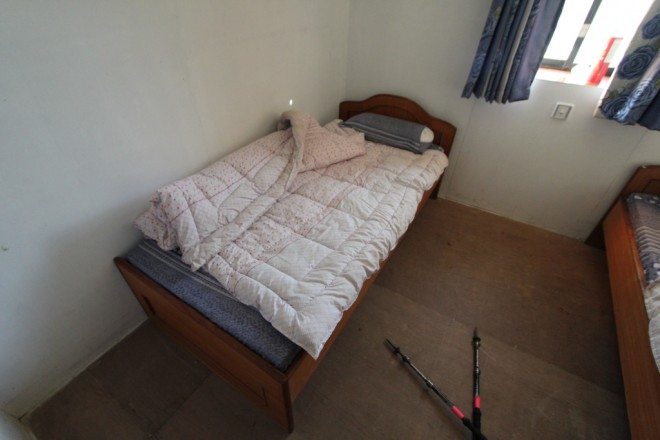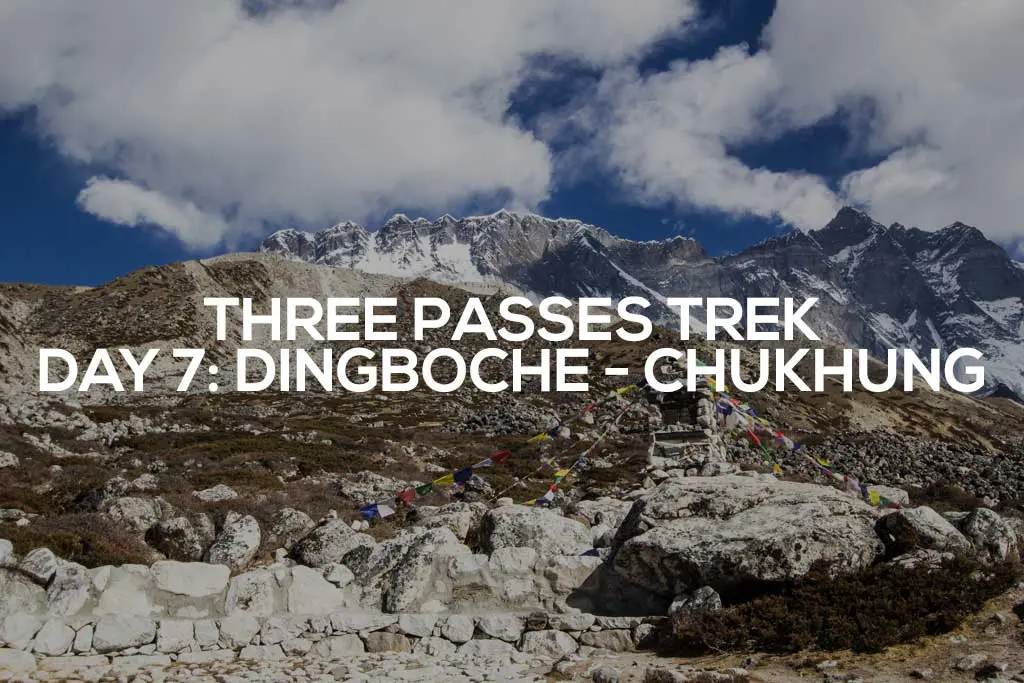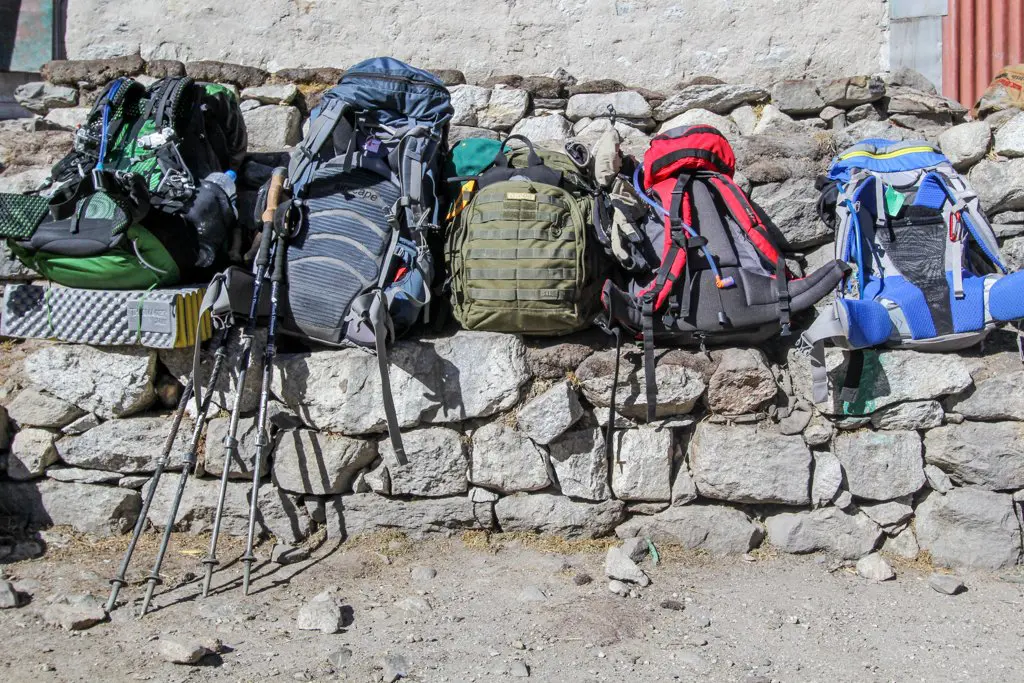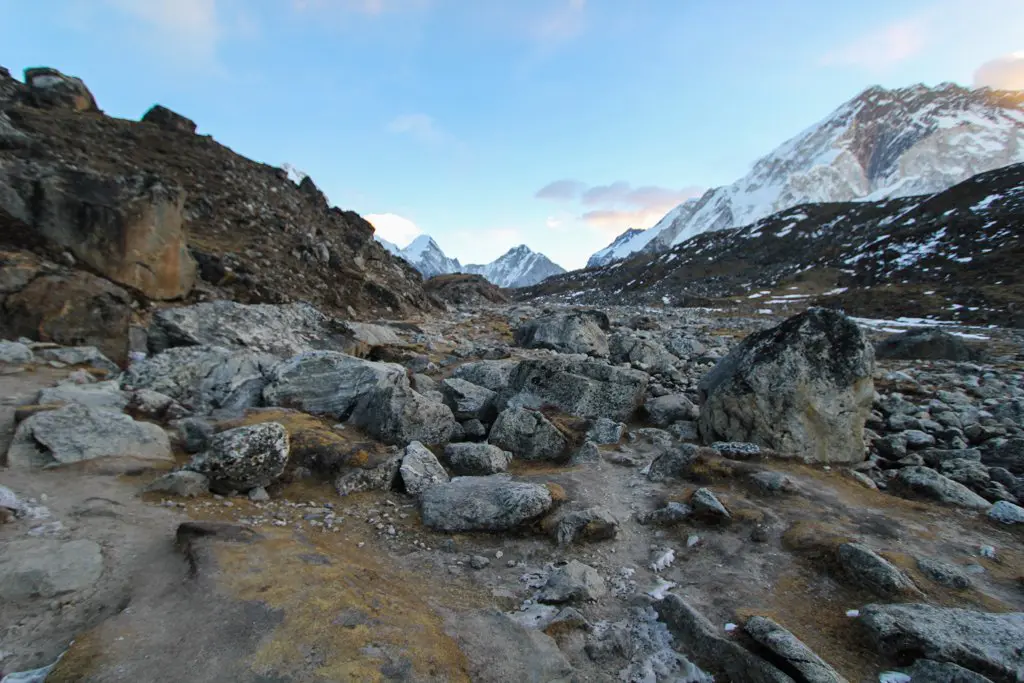Everest Base Camp Day 6: Chukhung Ri And Failed Acclimatization
- Starting elevation: 14,469 ft / 4,410 m
- Ending elevation: 15,518 ft / 4,730 m
- Elevation change: +1,049 ft / +320 m
- Starting oxygen: 59% of sea level
- Ending oxygen: 57% of sea level
- Distance covered: 6.9 mi / 11.1 km
- Time hiked: 7h 00m
Every step is a literal struggle.
I can’t go more than twenty feet without needing to sit down. I can’t even just stop to rest. I have to sit down.
Am I feeling nauseous? Is my vision getting blurry? Am I just tired from the climb? Are these symptoms, precursors to altitude sickness? Are they altitude sickness? Why again am I carrying my entire pack again? Is this all in my head? Am I going to die?
Halfway up Chukhung-Ri, I am now wondering if the summit was ever a realistic goal.
I sit and stare at the mountaintop as I gasp for air and attempt to summon strength to get back on my feet. I hate hiking.

My mustache covered in ice, I wake up at 6:20 to learn that I successfully survived the night without being trampled by yaks.
I pack up and head into the lodge for a dal bhat breakfast. What’s dal bhat, you ask? My understanding is that it is a traditional meal in Nepal that (usually) consists of rice and lentil soup (dal). Today, mine is accompanied by vegetables and some tortilla looking, odd tasting, piece of baked bread.
But what makes dal bhat really special is that it’s unlimited. Yes, unlimited. You can have unlimited refills of rice and lentil soup; I know, all your dreams. Aside from being economical and filling, dal bhat isn’t half bad as far as food goes (this is up for debate once you’re eating it for the seventh straight meal).
Typically, dal bhat is what I catch the porters and guides eating during mealtime, and if it’s good enough for them, then there must be something to it (or they’re simply being fed free and dal bhat is the cheapest thing to spare). But I suspect it gives you superpowers.
My Straya friends, Michael and Garth, emerge from their rooms to join me for a quick chat (and possible last meeting) before I set out in search of my day’s goal: the 18,209 ft / 5,550 m summit of Chukhung-Ri.

Today’s temperatures are the coldest of the trip, and I decide to hike with my synthetic base layer (as opposed to the wool base layer I also brought with me) for the first time this trip. My glove liners are also deemed necessary to keep my hands from freezing.
The trail follows a gentle slope on the northern side of a glacier-carved riverbed as I gradually climb the 1,000 or so feet (~300 m) up to the village of Chukhung. For the sixth straight day, the weather is spectacular, and the rising sun in the clear blue sky provides me with incredible views for the entire morning.
After two and a half hours, I reach my (first) destination at 15,518 ft / 4,730 m. My arrival comes just in time – the wind has picked up to violent levels and my eyes are now being blasted with dirt and what I can only assume is dried yak feces. Fighting to keep from being pushed over in the gusts, I take shelter inside one of the lodges (because nature if frightening).
Inside is an Australian couple on their way to Island Peak (Imja Tse), a 20,305 ft / 6,189 m peak a bit further east. Island Peak requires a bit more know-how and technical skills than I currently possess (and probably a guide, porter, and hefty climbing fee as well), but perhaps I shall see it conquered on one of my (many) subsequent trips to the Himalaya.

Candy bars here cost an outrageous 250 rupees each (~$2.50 US) so I decide that I will dig into my Kathmandu purchased supply (you can never have too much trail currency). If I want to make it up (and back down) Chukhung-Ri today, it’s time to get moving.
I have decided to bring my entire pack up to the summit instead of slackpacking. Why? Because some voice inside of me said it would serve me better in the acclimatization process (I should kill that voice inside of me). However, I actually suspect it to be because I have some serious separation anxiety when it comes to my pack.
I stop at a lodge on the edge of Chukhung to fill up on water and get yelled at by the owner for not wanting to buy anything after nicking a few liters (next time he won’t tell trekkers water is free).
Against a backdrop of massive snow-capped peaks, Chukhung-Ri looks nothing more than a barren hill of dirt and scattered boulders. Across the climb’s southern face, dozens of trails splinter, zigzag, and crisscross up through the sand to what I already know will be a false summit (but a small part of me is holding onto the impossible reality that it is the top).
Even though I know I am heading for a peak 2,690 ft / 820 m above me, I am somehow never quite ready for the climb. Luckily for me, the Chukhung-Ri hike starts violently upward. Hooray!

I overtake two slow-going, photo-happy, Japanese hikers in an effort to enhance their views and photos with my presence. Despite feeling strong (as is usually the case when beginning a climb) it seems no matter which trail I choose, I end up climbing more steeply than the alternatives (this must be some kind of Himalayan witchcraft).
Stopping for a break far too early into my climb to assess my situation (aka stopping to rest because I lied about feeling strong), Franklin from Brooklyn (whom I met in Tengboche) comes strolling up behind me. Franklin has (wisely) chosen to leave his pack below in Chukhung, and does a good job on calling me out on being an idiot for bringing mine along.
Energy levels replenished, I now attempt to match Franklin’s pace up; go ahead and add this to my ever-growing list of terrible, not thought out decisions. Before long I am ready to stop again, but I decide to push for the crest above us before surrendering to my fatigue.
As we approach the false summit’s plateau, the wind picks up and my gasps for air are now met with literal mouthfuls of dust and debris. It becomes too painful to keep my eyes open and I bury my face in my shirt attempting to control my breathing while each dust storm passes.
Finally in the clear, we meet with the climb’s only break from vertical gains (and a pack of yaks). I am exhausted. Franklin goes on ahead and before I know it my Japanese friends have come to claim their revenge as they pass me up without showing any signs of slowing down.

My every attempt to keep moving is met with an increasingly aggressive depletion of my stamina bar as I spend the next two hours slowly inching up towards the summit. Much frustration this is causing me.
Watching mountaineering documentaries from the comfort of wherever you happen to be in front of a screen it’s easy to think, “they’re already going so slowly, why can’t they just keep going for a few more steps”. Guilty of such thoughts myself, I now understand how these conquerors of mountains must feel during such times.
I never imagined that taking just one more step could be so incredibly difficult an obstacle, but when every step is your “last step”, things don’t go uphill very quickly. In fact, you might even say they’re going downhill. Heh.
My thoughts go to dark places. Am I feeling dizzy? Nauseous? Is the altitude sickness setting in or is this all in my head? It must be, right? Is impaired decision-making a symptom of altitude sickness? By any measure I am objectively exhausted, but is this the same way I would be feeling at sea level? There isn’t that much more altitude to be gained before the summit – could it really make that much of a difference?
The powerful dust storms continue to smash my spirits as I quickly learn that gasping for air whilst lost in a cloud of dust does little to inspire confidence that I can go on. It’s also freezing. The cold alone is enough to make me want to turn back, and I am now grateful that I have my gear with me as I put on my glove liners and puffy once more.

Before today, I could have never said with 100% confidence that I had “felt the effects of altitude”. Anything prior could have just as easily been all in my head. However, today, approaching an 18,209 ft / 5,550 m summit, where the oxygen is only 51% of sea level, I am seriously sucking wind.
Looking up, my destination doesn’t seem to be that far away, but when I account for the fact that I am only capable of moving in ten pace increments every minute or two, my goal is looking increasingly unrealistic.
Why I don’t just drop my pack to make the summit, I can only attribute to my decreased decision-making abilities. Against my better judgment, I continue pushing upward and meet Franklin on his way down. Slow cannot even begin to describe the pace I’ve adopted.
I continue my “press forward, sit and rest, don’t die” rhythm for the next thirty minutes before coming within range of the summit. On the verge of throwing up my dal bhat, I crawl through the last of the scree to make the summit. I collapse on the ground and decide it’s best to just lay motionless for a bit (aka bask in the glory of my most recent (and perhaps final) accomplishment).
I share the summit with my Japanese friends who are taking the last of their photos before heading down and leaving me alone, high up in the Himalaya (to die).

Once I get my breathing back under control, I realize that if I want to make it back to Dingboche before dark (or not too long after dark), I need to get moving immediately.
The way down Chukhung-Ri is long.
Aside from limbo and N64 Smash, I consider myself an expert downhill walker (it’s something I have trained at for years), but the way down Chukhung-Ri is exhausting. I tell myself I will break at the false summit, but when I arrive, I convince my legs that they are capable of making it all the way back down to Chukhung (stupid brain).
Keeping to the path of least resistance in the honeycomb of trails proves quite difficult, but I stop to assess the way down and find a familiar set of footprints – Franklin’s. Following his route down, I soon arrive back in Chukhung where I debate making a pit stop for water and a snack.
The sun has already hidden behind the mountains and with its disappearance, the temperature has begun to plummet. I need to sleep at (or near) the elevation I began at to successfully have acclimatized today (at least that’s what I should do). Unfortunately, Chukhung is 1,049 ft / 320 m higher than where I started.
Time to get back to Dingboche.

The sun quickly disappearing behind the mountains, I am determined to make it back. But approaching my morning’s entry point into Chukhung, I hear someone shouting behind me.
“Mac!”
“Franklin!” I have a sudden moment of clarity and manage to escape my altitude and exhaustion induced zombie trance, “Hey dude, what’s up?”
“Um…where are you going?”
Franklin proceeds to tell me I am crazy for wanting to hike back to Dingboche, and that I am probably better off staying the night in Chukhung (I believe the word “staggering” may have been used to describe the state of my movement).
Taking advantage of my precarious mental state, and employing his expert powers of persuasion (I believe the word “c’mon” was used), Franklin convinces me that I am better off holding up in Chukhung for the night and continuing back down (and then back up) tomorrow.
But wait, don’t I need to get back down today to acclimatize? And what does this mean for my allowed elevation gain tomorrow? Whatever, I guess if I wake up vomiting in the middle of the night I will know that I’ve made the wrong move by staying. Too worried to be bothered with things like my well-being right now.

Franklin goes on to persuade me that splitting a room with him would be a good move for both of us. Why I don’t simply continue my streak of sleeping outdoors for free or get my own room for the low, low price of 100 rupees (~$1 US), I’ll never know.
The guides took control of the lodge’s television and we spend the night watching a combination of Nepalese cop dramas (absolutely ridiculous), American action films (think Arnold and Stallone), and Indian music videos (my new favorite genre) as I filled myself with nearly four liters of water and tea to cure my dehydration and restore my mind to a near-rational state.
I also learned a few things about Viagra (yes, the penis erecting medication):
- Apparently some people use Viagra to combat the effects of altitude sickness.
- Viagra does not immediately cause a penis to become erect, it simply makes it easier to achieve an erection (i.e. arousal is still necessary).
Don’t say I never taught you anything.

EBC Day 1 | 1.5 | 2 | 2.5 | 3 | 4 | 5 | 6 | 7 | 8 | 9 | 9.5 | 10 | 10.5 | 11 | 12 | 13






